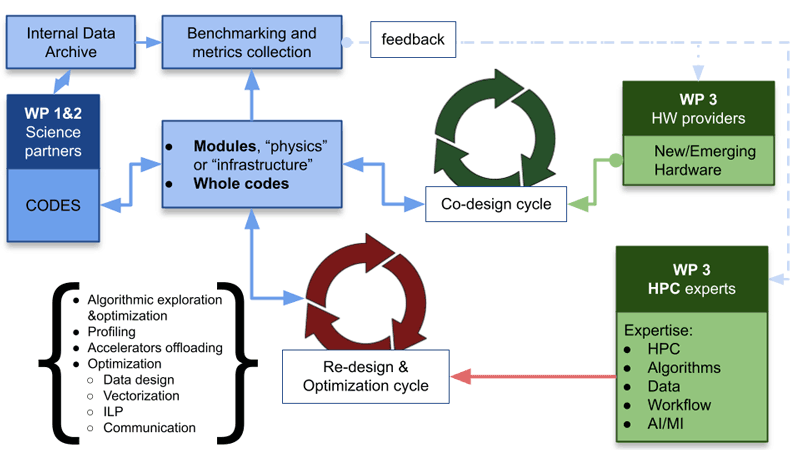by Marisa Zanotti (EnginSoft), Andrea Mignone (University of Torino) and Manolis Marazakis (ICS-FORTH)
In astrophysics and cosmology (A&C), high-performance computing (HPC)-based numerical simulations are invaluable instruments to support scientific discovery. The efficient and effective exploitation of exascale (and beyond) computing capabilities will be key to paving the way for scientific discovery in this scientific domain, but requires a coordinated effort towards adapting A&C codes for space applications on exascale HPC systems.
In astrophysics and cosmology (A&C), HPC (high-performance computing)-based numerical simulations are invaluable instruments to support scientific discovery. They represent essential tools for modelling, interpreting, and understanding the complex physical processes behind the observed sky. Advances in computational power promise a wealth of ground-breaking scientific discoveries by making ever greater numerical simulations feasible, provided that equally advanced tools are created to exploit these computational resources. Moreover, the outstanding quality and volume of observational data generated by the current and next generation of instruments (eg. LOFAR, MeerKAT, MWA, EUCLID, SKA) poses exceptional challenges to their theoretical interpretation and will require novel theoretical and numerical simulation capabilities (codes, algorithms and tools) able to investigate the physical processes behind the observed phenomena with unprecedented quality, resolution and reliability, allowing their interpretation and paving the way for scientific discovery.
For a field like A&C, which is generally unsuited to direct experiments, the significance of this development cannot be underestimated. Future exascale computing systems are expected to have extremely complex, heterogeneous architectures [1]. The currently used numerical simulation codes are not suitable for use on such systems, since they were not purposely designed for them and therefore cannot effectively take advantage of the superior processing capabilities expected. Therefore, the efficient and effective exploitation of exascale (and beyond) computing capabilities will be key to achieving the anticipated exceptional results in A&C, combined with high-performance data processing, interactive real-time analysis, and data visualisation to explore large volumes of data, compare observations with simulations, and finally implement multi-wavelength and multi-messenger science. Nowadays, a limited number of numerical applications, several of which are developed and maintained in Europe, represent the state-of-the-art in A&C simulations. However, although they are production codes used in cutting-edge simulations, they also require a substantial effort to evolve their computational paradigms from the petascale to the exascale era.
The main goal of the SPACE Centre of Excellence is to enable current astrophysical and cosmological codes to be used on the pre-exascale HPC architectures funded by the EuroHPC JU and made available at the end of 2022, as well as on upcoming exascale architectures, by re-designing or adapting the existing computational tools for next-generation HPC hardware platforms. SPACE brings together scientists, community code developers, HPC experts, hardware manufacturers and software developers in co-design activities (Figure 1) to re-engineer eight of the most widely used European A&C HPC codes into new products that can efficiently exploit future computing architectures.

Figure 1: Re-design/optimisation and co-design cycles.
These eight A&C HPC codes represent 70% of the HPC A&C simulations, and were selected after an extensive analysis of their features and capabilities. They will initially be prepared to adequately exploit the pre-exascale systems with a view to their transition to exascale systems and beyond. At the same time, SPACE will work to advance workflows and data processing based on machine learning and visualisation applications, and to enhance their scalability on exascale systems. Contrasting the results from numerical simulations with the torrent of complex observational data from the new generations of ground- and space-based observatories will be the fundamental method to provide new insights into astronomical phenomena, the formation and evolution of the universe, and the fundamental laws of physics.
SPACE brings together a significant fraction of the numerical A&C European community from eight different countries, having as partners: University of Turin (Coordinator), INAF, CINECA, E4 and EnginSoft Spa from Italy; Universiteit Leuven from Belgium; VSB-Technical University of Ostrava from Czechia; CNRS and BULL from France; LMU and Goethe University from Germany; FORTH from Greece; University of Oslo from Norway; BSC from Spain.
Furthermore, SPACE will promote the adoption of general and community standards for data products based on FAIR principles [2], and the interoperability of data and applications based on the technology standards and best practices of the International Virtual Observatory Alliance (IVOA) [3].
SPACE will also implement the selected applications and foster their use by means of an outreach and training programme aimed at creating a broad and skilled talent pool in Europe to boost the use of high-performance and high-throughput solutions in academia in order to pave the way for the transition to exascale technologies and beyond. More information on the work plan and outcomes of SPACE is available via the project’s website [L1] and social media channels [L2, L3].
SPACE CoE is funded by the European Union. It has received funding from the European High Performance Computing Joint Undertaking and from Belgium, the Czech Republic, France, Germany, Greece, Italy, Norway, and Spain under grant agreement No. 101093441.
Links:
[L1] https://www.space-coe.eu/
[L2] https://kwz.me/hxc
[L3] https://twitter.com/CoeSpace50804
References:
[1] M. Schulte, et al., “Achieving exascale capabilities through heterogeneous computing,” IEEE Micro, vol. 35, no. 04, pp. 26–36, 2015.
[2] M. Wilkinson, M. Dumontier, I. Aalbersberg, et al., “The FAIR guiding principles for scientific data management and stewardship,” Scientific Data, 3, 160018, 2016, https://doi.org/10.1038/sdata.2016.18
[3] G. B. Berriman, The IVOA Executive Committee, The IVOA Technical Coordination Group and The IVOA Community, Proc. of The International Virtual Observatory Alliance in 2020, 2020. https://doi.org/10.48550/arXiv.2012.05988
Please contact:
Maria Zanotti, EnginSoft Spa, Italy











